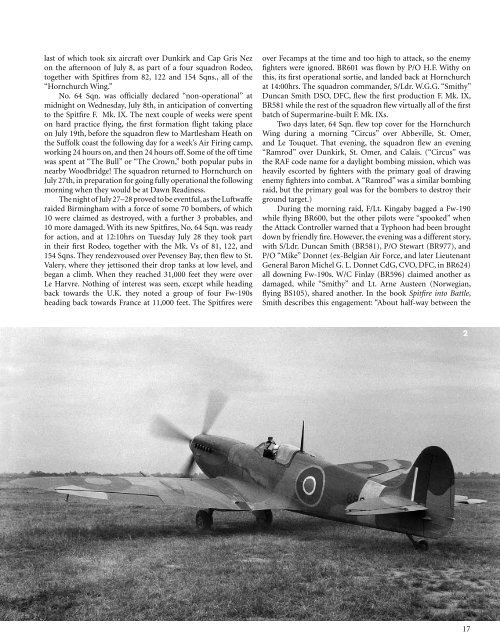WD74W2
You also want an ePaper? Increase the reach of your titles
YUMPU automatically turns print PDFs into web optimized ePapers that Google loves.
last of which took six aircraft over Dunkirk and Cap Gris Nez<br />
on the afternoon of July 8, as part of a four squadron Rodeo,<br />
together with Spitfires from 82, 122 and 154 Sqns., all of the<br />
“Hornchurch Wing.”<br />
No. 64 Sqn. was officially declared “non-operational” at<br />
midnight on Wednesday, July 8th, in anticipation of converting<br />
to the Spitfire F. Mk. IX. The next couple of weeks were spent<br />
on hard practice flying, the first formation flight taking place<br />
on July 19th, before the squadron flew to Martlesham Heath on<br />
the Suffolk coast the following day for a week’s Air Firing camp,<br />
working 24 hours on, and then 24 hours off. Some of the off time<br />
was spent at “The Bull” or “The Crown,” both popular pubs in<br />
nearby Woodbridge! The squadron returned to Hornchurch on<br />
July 27th, in preparation for going fully operational the following<br />
morning when they would be at Dawn Readiness.<br />
The night of July 27–28 proved to be eventful, as the Luftwaffe<br />
raided Birmingham with a force of some 70 bombers, of which<br />
10 were claimed as destroyed, with a further 3 probables, and<br />
10 more damaged. With its new Spitfires, No. 64 Sqn. was ready<br />
for action, and at 12:10hrs on Tuesday July 28 they took part<br />
in their first Rodeo, together with the Mk. Vs of 81, 122, and<br />
154 Sqns. They rendezvoused over Pevensey Bay, then flew to St.<br />
Valery, where they jettisoned their drop tanks at low level, and<br />
began a climb. When they reached 31,000 feet they were over<br />
Le Harvre. Nothing of interest was seen, except while heading<br />
back towards the U.K. they noted a group of four Fw-190s<br />
heading back towards France at 11,000 feet. The Spitfires were<br />
over Fecamps at the time and too high to attack, so the enemy<br />
fighters were ignored. BR601 was flown by P/O H.F. Withy on<br />
this, its first operational sortie, and landed back at Hornchurch<br />
at 14:00hrs. The squadron commander, S/Ldr. W.G.G. “Smithy”<br />
Duncan Smith DSO, DFC, flew the first production F. Mk. IX,<br />
BR581 while the rest of the squadron flew virtually all of the first<br />
batch of Supermarine-built F. Mk. IXs.<br />
Two days later, 64 Sqn. flew top cover for the Hornchurch<br />
Wing during a morning “Circus” over Abbeville, St. Omer,<br />
and Le Touquet. That evening, the squadron flew an evening<br />
“Ramrod” over Dunkirk, St. Omer, and Calais. (“Circus” was<br />
the RAF code name for a daylight bombing mission, which was<br />
heavily escorted by fighters with the primary goal of drawing<br />
enemy fighters into combat. A “Ramrod” was a similar bombing<br />
raid, but the primary goal was for the bombers to destroy their<br />
ground target.)<br />
During the morning raid, F/Lt. Kingaby bagged a Fw-190<br />
while flying BR600, but the other pilots were “spooked” when<br />
the Attack Controller warned that a Typhoon had been brought<br />
down by friendly fire. However, the evening was a different story,<br />
with S/Ldr. Duncan Smith (BR581), P/O Stewart (BR977), and<br />
P/O “Mike” Donnet (ex-Belgian Air Force, and later Lieutenant<br />
General Baron Michel G. L. Donnet CdG, CVO, DFC, in BR624)<br />
all downing Fw-190s. W/C Finlay (BR596) claimed another as<br />
damaged, while “Smithy” and Lt. Arne Austeen (Norwegian,<br />
flying BS105), shared another. In the book Spitfire into Battle,<br />
Smith describes this engagement: “About half-way between the<br />
2<br />
17


